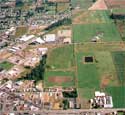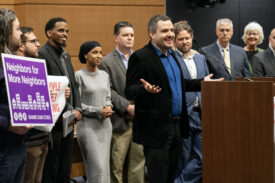The conventional wisdom is that it’s cheaper to live in the outer suburbs (ie., a long drive from jobs, stores, or schools) than closer to a town or city center. I suppose that’s true enough—if you’re looking only at the cost of housing.

Which leads to the obvious question: what happens if you combine transportation costs and housing costs into a single budget? Is living at the urban fringe still cheaper?
There have already been a couple of attempts (see, e.g., here) to look this issue. Now there’s a new study, noted here in The Washington Post. The key finding: when you combine travel and housing, living in a suburban outpost can cost more than living closer to a town or city center. According to the study’s author:
“Even if you save a couple of hundred dollars a month on your mortgage, it doesn’t nearly outweigh the costs of the cars you are driving.”
Obviously, the more money you spend on your car, the more you’re sinking into a depreciating asset. Buy a house, and a decade later, it’s worth more than you paid for it (provided you didn’t buy at the top of a bubble). Buy a car, and a few years later, you’ve got a bunch of gas receipts and a car that’s worth just a fraction of what you paid for it.
Which means that shifting your spending from your car to your home can be a good way of boosting your long-term finances.
Another point worth noting:
The study found that most people in the outer suburbs pay so much for transportation not just because of long commutes but also because they have to use their cars for nearly every errand and trip.
That seems right to me. When most people think about transportation costs, they think about commuting. But for the typical household, commuting represents a surprisingly small share of total driving. And if you live in the sort of place where every trip—every errand, social visit, you name it—requires a car, the miles and the costs can add up quickly.
Now, on the one hand, it seems that a study like this reveals something genuinely new. Many folks who’ve chosen long commutes to inexpensive houses may just not have done the math, to tally up the cost of all that travel. If they’d really taken the time to consider the savings they might reap if they could drive less—or even get rid of one of the family cars—maybe they would have chosen a different place to live.
But on the other hand, not everybody will be swayed by this sort of reasoning. People looking to buy a house in the exurbs aren’t just looking for cheaper housing. Lots of people are looking for something else—a big yard, a sense of privacy or solitude, a school system where they think their kids will be better off, a certain kind of community layout. And they’re willing to pay for those things—perhaps not in housing costs, but certainly in money and time spent on, and in, their cars.
But in the end, there’s no inherent reason that people can’t find good communities, or good, safe schools, or quality open space, or even privacy, in more densely populated places. Those kinds of livable, urban and dense suburban neighborhoods exist already—there just aren’t enough of them. And that’s what makes housing there so expensive: lots of people want to live there, so the demand is high; but there’s not much of a supply.
So if we do a good job with increasing the supply of good neighborhods—creating lots of the kinds of with a high quality of life, and where stores, services and jobs are close by—then high-quality housing will become more affordable, even as transportation costs fall.
Of course, there is one exception to the we-can-have-it-all fantasy in the preceding paragraph: big yards, fenced off from the public. It seems to me that there’s just no way to give everyone a big lawn and a short commute. The math just doesn’t work out: big yards just spread everything too far apart, and cars start to become a dire necessity rather than an occasional convenience.
Which leads me to believe that you really can have affordable housing and transportation, great neighborhoods, and great big yards. You just can’t have all three at once.









Dan
‘Princlple’.(you can delete this).
Dan
Ahem. ‘preview’, Dan. ‘Principle’. Crikey.
Dan
OK, piling on the embarrassment, I get the homonym now. I guess you’ll be leaving all this up as payback for something I said some time in the past…[blushes]Humbly,
MichelleV.P.
[On principle, having also been confused, sweeps in to Dan’s rescue.]It’s OK, Dan, I had to go here to understand the “investment” in this joke!
Clark Williams-Derry
Dan – no worries.I’d be happy to delete the comments, if you want…
Dan
Thank you Michelle. Best not to destroy the evidence, Clark.BTW, Grist had a decent recap of the property rightist’s movement yesterday, even riffing on Sightline‘s catchy tune:While such decisions might reduce the perceived value of one landowner’s property, they may actually increase the value of nearby property by keeping a neighborhood more clean and desirable, or by restricting the amount of land available for new housing, thus making existing housing more sought after. In fact, this complexity suggests that the fundamental premise of the initiatives may be flawed. “Some people have asked, If there is such a thing as a regulatory taking, aren’t there just as many regulatory ‘givings’?” says David Goldberg, communications director of Smart Growth America.Regards,
MichelleV.P.
BTW, just to be clear, that is a great title, Clark 🙂
Matt the Engineer
Perhaps what we really need is to fit our city housing model to the population’s need for a yard. How? One way would to take a standard city residential property, and build on the entire lot (we’ll need to change codes for this). Build up a story or two, and end with a flat roof. Make this roof a green roof, and add a sturdy railing or wall. You’ll end up with a larger house (one benefit to suburb living) along with a large flat yard.
Alan Durning
Good thinking, Matt.Another idea: at least in Seattle, builders put up “skinnies” and “four packs” that are separated from each other by a few feet of wasted outdoor space. In some parts of the city, including my neighborhood of Ballard, these four-pack homes are towers—basically a garage on the ground floor and one or two rooms on each floor above. Four levels of flats would make much more efficient use of the same space and allow more usable outdoor space. Similarly, townhouses have always seemed an elegant solution. Shared walls maximize useful yard space in the back. They also conserve heating and cooling energy.Finally, building contiguous urban dwellings around a shared, common “green” (as in the final scene in Notting Hill)–one in the center of each block—might make more efficient use of yard space than the normal Cascadian pattern of each home in the center of its lot. Many co-housing projects achieve similar results in creative ways: small, private gardens and larger, shared lawns and play areas.
hearth
Even the corrected title, “Commuter-Pay Principle” is a little off, as the use of the automobile, both driving it and parking it, is heavily subsidized. The high price of “location-efficient” housing is partly due to its short supply, and partly due to the fact that it saves on transportation costs (not just $$, but time and stress). The questions that no one is addressing—including “smart growth” groups—is how to re-vamp suburbs that were built after the arrival of the car to include elements of location efficiency.The best indicator of such a quality is the neighbourhood’s _requirement_ to own a car—as shown by the _number_ of household vehicles and their age (a car is driven less as it ages)—and the community’s _walkability_, as shown by not just the walker’s immediate environment but the availability of a full spectrum of useful destinations within walking distance.Chris Bradshaw, Ottawa
Dan
The questions that no one is addressing—including “smart growth” groups—is how to re-vamp suburbs that were built after the arrival of the car to include elements of location efficiency. Sure they are. See any form-based code or smart-growth code that provisions live-work spaces. Regards,
MichelleV.P.
Apropos to Clark’s story, over on Gristmill, commenter KathyF calls attention to an interesting counter-trend:City-dwellers are commuting to the suburbs because there are more shopping options (i.e. department stores) available there than in the city.She then asks an intriguing question, “So when are we going to have the study about the high commuting costs of living in the city?”
Levin
Even in existing suburbs, “affordable housing and transportation, great neighborhoods, and great big yards” can be created, if we share each great big yard with a few neighbors. Community Greens and GreenwayNeighborhoods.net are websites exploring the question of shared urban greenspace. For transportation, Curitiba, Brazil has created a world-class and inexpensive public transit system by transforming ordinary urban streets into one-way couplets with express bus routes.